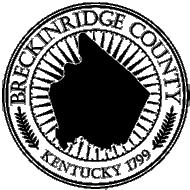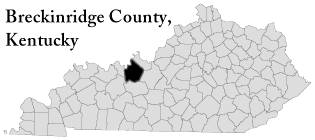 |
USGenWeb Archives Project Breckinridge County, Kentucky |
 |
 |
 |
 |
 |
USGenWeb Archives Project Breckinridge County, Kentucky |
 |
 |
 |
 |
THESE
ARCHIVES BUILT BY YOUR
CONTRIBUTIONS.
PLEASE CONTRIBUTE TODAY!
New
Easy to use Submission
Forms!
This Page Updated Monday, 11-Apr-2022 20:27:48 EDT
| BRECKINRIDGE COUNTY, KENTUCKY |
| AREA COMMUNTIES OF THE PAST AND PRESENT |
| HUDSON |
In
1810, Joseph Hudson first came to Breckinridge County and took
up land, as they
called it, in the Hudson community.
This was the first
settler to invade that section of the county.
This was
seven
years after Joesville, now Cloverport, was settled.
Stephensport
was settled that same year. Six
generations have
passed since Joseph Hudson came to this community.
The land
has never been out of the family.
It has been handed
down from generation to generation.
The original house
built by Joseph Hudson is still standing.
Some repair has
been made from time to time. Bert
Keesee now lives in the
old original homestead and warms his feet at the same fire place
and sets in the same log living room that his grand-sire or six
generations ago built.
Among the first settlers who followed Mr. Hudson to this
community were George Holmes, Rafeal Cox, Doctor
George Legrand, Steve Critchelow, who was the father of Bill and
Tom who ran the mill and blacksmith shop at McDaniels for
some 60 years, Henry Tucker, and Mac Jauncy.
This community
loaned four of its citizens to the Union Army during the
Civil War, Elza Tucker, Bill Tucker, Bill Monroe, Nic Mercer.
Fortunately all of these returned safely. Nor did the
community completely escape the ravages of the war.
In
1864, the Gorillas came through Hudson, stealing all the best
horses; often times, leaving their worn out or emaciated rack of
bones in their stead. One
group of such Gorillas plundered
all the houses in the community, taking with them such woolen
goods and clothing that was of any value.
On one occasion
these Gorillas gave chase to Mr. George Holmes who was returning
home from Hardin Springs with a turn of meal on his prize mare.
These Gorillas
tried to hail him and, knowing what they
wanted, he gave them a race for about three or four miles, but
his
mare, not being accustomed to this type treatment, the customary
trade was made, leaving poor Mr. Holmes with a rack of bones that
could hardly walk. So
he was obliged to walk the remaining
distance home leading his newly acquired horse and carrying the
turn of meal on his own back.
Too often we have overlooked the patriotism and credit
that is
due the women folks in these early pioneer days.
During this Civil
War when our men folks were either in
battle or they were forced to put every minute to the task of
raising provisions,
Mrs. Henry Tucker, the grandmother of the W. H. Tucker, who is
still, at age 81, operating the post office and general store in
the community,
drove a yoke of oxen hitched to a tar-pole wagon from
Hudsonville, as it was called at that time, to Gray Hampton
taking a turn of corn for
all of the neighbors in the community.
This was a walk for
some 60 miles. This
tar-pole wagon, of which I spoke, was
made
altogether of wood, with the exception of an iron rim around the
tire. The hubs were
greased with pine tar.
Soon after the Civil War and during the reconstruction
period a
Mr. Mac Jauncy built a gristmill in the forks of Calimese
Creek where the people of that community could grind their own
meal. This mill had
to be powered by a horse. It
had
a long
sweep pole resembling our sorghum mills of which most of us are
familiar. Each
person who brought a turn of corn to be
ground must
hitch his own horse to the sweep pole and grind his own corn.
Seldom, if ever, was Mr. Jauncy present since he had his
own farm
work to look after. But
each customer left a toll of meal
in a bin that was placed there for that purpose.
Doctor George Legrand was the first doctor in this part of
the
county. He brought
with him several slaves and a part
of this land is still in the Legrand family.
In 1960, Mace
Legrand, a veteran of 91 years, passed on leaving the remaining
portion of
the homestead to his son, Roy.
About one hundred yards east of Hudson crossroads on the
road to
Dyer, a Mr. Riley Johnson built and operated a
distillery until the 18th Amendment was passed. Mr.
Scott Proctor, from Leitchfield, was the gager.
All of his
whiskey,
carrying a government seal, had to be 100 proof.
It was put
in wooden barrels that had been charred on the inside, and hauled
to
Leitchfield where it was shipped; most all except, and I quote
Mr. W. H. Tucker, “A sizable amount that was consumed here
in this
community.” This
distillery was in operation about the
time the Mormons were being persecuted in the eastern part of the
United
States. Two
preachers of this sect came through Hudson one
evening and stopped at the inn which was also owned and operated
by Mr. Riley Johnson. They,
being destitute, asked for a
night’s lodging and a small handout before resuming their
journey.
After contributing
to their needs, Mr. Johnson asked of
the pair where they were going. They
answered, “We are
following
in the footsteps of our Master, Jesus Christ.” At his
Johnson gave reply, “Hell fire, fellows!
You are too
late.
Christ went by
here 2000 years ago.” With
the
18th Amendment this industry came to an abrupt
end.
The first school in this community was on top of the hill
some
300 yards going towards Dyer. It
was made of
logs, the seats were split logs with pegs driven in them for
legs. This dated
back to about 1840. The
next school
was
about 200 yards down the Fairfield road.
It was a frame
building which gave way to the ravages of termites, old age, and
the
Barlow knife. A new
school was then built at the top of the
hill on the road towards Madrid. It
was completed in 1890,
the year of the big cyclone, but like others, lasted out its day.
The last school in the town was built on land donated by
W. H.
Tucker in 1924. The
author taught his first school in this
one-room building, having 58 students and all eight grades.
This
last school was abandoned in 1957, and consolidated with Custer.
The town now consists merely of two stores, a Methodist
Church and Masonic Lodge. W.
H. Tucker has run the general
store there since 1930, and his wife the post office since 1936.